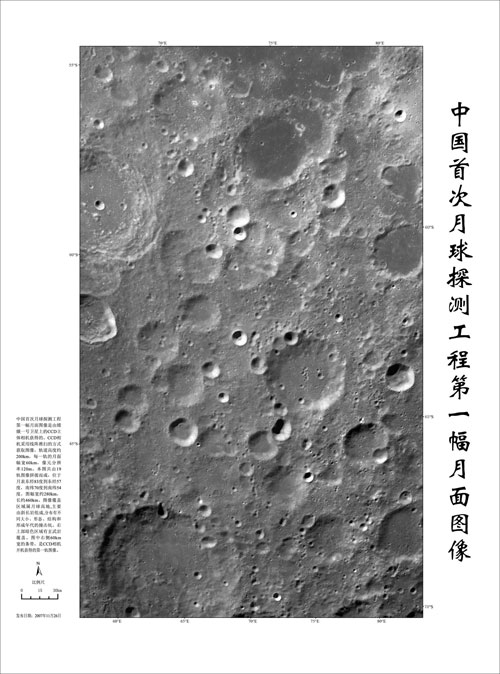|
|
| (4 intermediate revisions by the same user not shown) |
| Line 1: |
Line 1: |
| | __NOTOC__ | | __NOTOC__ |
| | =Hooray, Chang’E!= | | =Hooray, Chang’E!= |
| | + | <!-- Start of content --> |
| | <div class="post" id="post-1547"> | | <div class="post" id="post-1547"> |
| | | | |
| Line 7: |
Line 8: |
| | <em>image by [http://www.cnsa.gov.cn/n615708/index.html China National Space Agency]</em></p> | | <em>image by [http://www.cnsa.gov.cn/n615708/index.html China National Space Agency]</em></p> |
| | <p>UPDATE: Full resolution [http://planetary.org/news/2007/1127_First_Image_of_the_Moon_by_Chinese.html image!] Make sure to hit “Click to enlarge” button at bottom. </p> | | <p>UPDATE: Full resolution [http://planetary.org/news/2007/1127_First_Image_of_the_Moon_by_Chinese.html image!] Make sure to hit “Click to enlarge” button at bottom. </p> |
| − | <p>Looking as unfamiliar as a piece of the farside, the first image of the Moon taken by China’s Chang’e orbiter stretches from dark-floored Hanno H to Helmholtz at bottom left. This view of the southeast limb is actually a composite of 19 frames, each 60 km wide, taken on Nov 20 and 21. When available at full size the mosaic will have a nominal resolution of 120 m, roughly comparable to that of Lunar Orbiter IV (58 - 134 m), Clementine (100 m) and SMART-1 (50 m). The relatively high Sun angle of this image would be excellent for multi-spectral mapping (yet to come), but lower illumination is needed for the finest detailing of morphology; I don’t know how much opportunity there is to image under different illumination angles, but Chang’e is planned to remain in lunar orbit for at least a year so there probably will be multiple mappings of the lunar surface. I don’t know when (if ever) there have been two active spacecraft orbiting the Moon (perhaps when the Soviet Union was trying to beat Apollo to the Moon?), but there are today, both sophisticated and highly capable of providing the detailed compositional, morphological and topographical information needed to understand our sister world. Congratulations to China’s Chang’e and to Japan’s [http://www.lpod.org/?m=20071114 Kaguya]! </p> | + | <p>Looking as unfamiliar as a piece of the farside, the first image of the Moon taken by China’s Chang’e orbiter stretches from dark-floored Hanno H to Helmholtz at bottom left. This view of the southeast limb is actually a composite of 19 frames, each 60 km wide, taken on Nov 20 and 21. When available at full size the mosaic will have a nominal resolution of 120 m, roughly comparable to that of Lunar Orbiter IV (58 - 134 m), Clementine (100 m) and SMART-1 (50 m). The relatively high Sun angle of this image would be excellent for multi-spectral mapping (yet to come), but lower illumination is needed for the finest detailing of morphology; I don’t know how much opportunity there is to image under different illumination angles, but Chang’e is planned to remain in lunar orbit for at least a year so there probably will be multiple mappings of the lunar surface. I don’t know when (if ever) there have been two active spacecraft orbiting the Moon (perhaps when the Soviet Union was trying to beat Apollo to the Moon?), but there are today, both sophisticated and highly capable of providing the detailed compositional, morphological and topographical information needed to understand our sister world. Congratulations to China’s Chang’e and to Japan’s [[November_14,_2007|Kaguya]]! </p> |
| | <p>[mailto:tychocrater@yahoo.com Chuck Wood]</p> | | <p>[mailto:tychocrater@yahoo.com Chuck Wood]</p> |
| | <p><strong>Related Links:</strong><br /> | | <p><strong>Related Links:</strong><br /> |
| | Rükl Limb Chart V<br /> | | Rükl Limb Chart V<br /> |
| | [http://www.chinadaily.com.cn/china/2007-11/26/content_6279311.htm More]</p> | | [http://www.chinadaily.com.cn/china/2007-11/26/content_6279311.htm More]</p> |
| − | <p align="center"><em>Now you can support LPOD when you buy ANY book (or Christmass present) from Amazon thru [[LPOD]]</em></p> | + | <p><b>Yesterday's LPOD:</b> [[November 26, 2007|Flying Over Tycho]] </p> |
| | + | <p><b>Tomorrow's LPOD:</b> [[November 28, 2007|Full Res!]] </p> |
| | + | <!-- Removed reference to store page 2 --> |
| | </div> | | </div> |
| − | ---- | + | <!-- End of content --> |
| − | ===COMMENTS?===
| + | {{wiki/ArticleFooter}} |
| − | Click on this icon [[image:PostIcon.jpg]] at the upper right to post a comment.
| |




